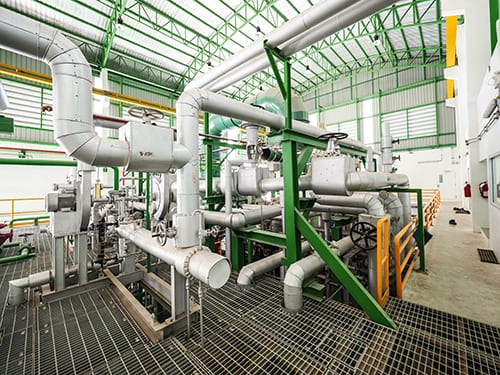Part 2 continues the series on recommended water/steam chemistry monitoring guidelines for high-pressure steam generators. The focus here is on the condensate system. Feedwater monitoring is closely related and will be examined in the next article of this series.
In steam generating power units, the primary location for potential contaminant ingress is the condenser, particularly water-cooled condensers where a tube leak(s) allows cooling water to infiltrate the high-purity condensate. Cooling water in-leakage will introduce many impurities to the steam generator, which, when subjected to the harsh environment in the boilers (the common term for HRSGs is evaporators) can cause serious problems.
Recommended continuous condensate pump discharge (CPD) analyses are:
- Cation conductivity (CACE): ≤0.2 µS/cm
- Specific conductivity (SC): consistent with pH
- Sodium: ≤2 ppb
- Dissolved oxygen: ≤20 ppb
- pH: 9.6–10.0 (this is the pH range for the most common HRSG design, the triple-pressure, feed-forward low-pressure type. The range may be a bit different for other HRSG designs.)
Sodium monitoring is very effective for detecting condenser tube leaks. With a tight condenser, sodium levels in the condensate are normally very low (<2 ppb), in many cases, less than 1 ppb. A rise in sodium provides the earliest indication of a condenser tube leak.
Cation conductivity has been re-designated by some research organizations as conductivity after cation exchange (CACE) to illustrate the fact that the sample is routed through a cation exchange column to replace the cations, e.g., ammonium, sodium, calcium, etc. with hydrogen ions. This creates a very dilute acid solution of primarily trace amounts of chloride and sulfate ions, whose conductivity is then measured. As with sodium monitoring, a rise in CACE indicates impurity in-leakage. CACE can be influenced by carbon dioxide ingression, usually from air in-leakage at the condenser. Becoming increasingly popular is degasified CACE, which utilizes either a re-boiler or nitrogen sparging compartment to remove up to 90% of the carbon dioxide.
Dissolved oxygen (DO) analyses are important for monitoring condenser air in-leakage. A sudden increase in dissolved oxygen may indicate a mechanical failure at or near the condenser, which allows excess air to enter the system. Given that modern condensate/feedwater chemistry programs require tight control of DO concentration, this monitoring parameter is very important.

A packaged dissolved oxygen analyzer. Photo courtesy of Hach.
Regarding the relationship between specific conductivity and pH, ammonia (or sometimes an amine or ammonia/amine blend) is the normal pH-conditioning agent for condensate/feedwater. However, direct pH measurement of high-purity water can be tricky, and algorithms have been developed to calculate pH based on SC and CACE measurements to provide more accurate results. SC in high-purity water is directly correlated to the ammonia concentration, so SC measurements offer better control of ammonia feed than pH.
A parameter not typically monitored continuously, but which can be of some importance is total organic carbon (TOC). For utility steam generators, the recommended TOC limit in the CPD is 100 ppb.
Finally, an increasing number of new plants are being equipped with an air-cooled condenser (ACC) as a water conservation measure, reducing issues with cooling water ingress to the condensate. However, because air is so much less dense than water, an ACC should correspondingly be that much larger, which literally requires many thousands of feet of carbon steel piping. The principal condensate contaminant in units so equipped is iron oxide particulate. Some type of particulate filter is recommended to prevent iron oxides from reaching the steam generator. Look for a separate post discussing this issue.
ChemTreat has experience with steam generator water chemistry monitoring and treatment. Contact us for assistance in designing a treatment program customized for your application.
Like all other technologies, due diligence is necessary to determine the feasibility for utilizing methods. Always consult your equipment manuals and guides.

